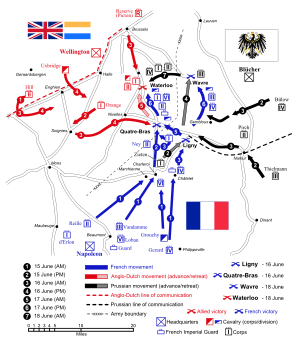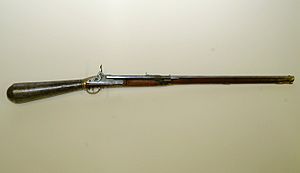Napoleonic weaponry and warfare facts for kids
Napoleon I was a famous French leader and one of the best military commanders ever. He was the Emperor of the French and led his armies to many victories. His main plan was to focus on one part of the enemy's army. He would defeat them quickly and then move on to the next challenge. Napoleon's success came from his strong will and the way his army was organized. The French government controlled all the weapons and equipment. This helped make sure his army was well-supplied.
Contents
Fast Moves: Napoleon's Secret Weapon
One of Napoleon's biggest advantages was how fast his troops could move. He always wanted his army to march, move, and attack very quickly. He once said that losing time in war is something you can never get back. He believed he might lose a battle, but he should never waste a minute.
Many things helped Napoleon's army move so fast. His army was split into independent groups called "corps." Each corps could act on its own. He also avoided long and slow supply lines. Instead, Napoleon's army lived off the land. Their motto was: "The war must feed the war." This meant they would get food from the areas they were fighting in. They would either pay friendly countries or simply search for food.
These fast movements, along with Napoleon's ability to inspire his soldiers, led to many victories. His enemies were often confused and surprised by his quick and well-planned attacks.
Smart Plans: How Napoleon Won Battles
The French Revolution and the wars that followed, called the Napoleonic Wars, completely changed how armies fought. These changes were still important even during the American Civil War and the early parts of World War I.
Back then, weapons became cheaper, and more ordinary citizens joined the army. This meant armies grew very large. To manage these huge forces, armies were first divided into divisions and then into corps. Each division also had its own artillery. These were light, mobile cannons that could shoot far and had great power.
Napoleon always wanted to win battles decisively. His main goal was to completely destroy his enemy. He usually did this by moving his troops better than his opponents. As a ruler and general, he planned both big picture strategies and smaller battle plans. He used political and economic ideas to help his military goals.
Napoleon was very good at combining troop movements and the actual battle into one smooth event. Before him, generals saw these as separate steps. But Napoleon used his troop movements during a battle to control where and how the fight would happen. The Battle of Austerlitz is a great example. Napoleon pretended to retreat from a strong position. This tricked his enemy into attacking his flank, which weakened their middle. This allowed the French army to split the enemy army and win.
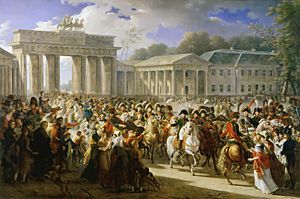
Napoleon used two main strategies to approach battles. His "Manoeuvre De Derrière" (which means "move onto the rear") aimed to place the French Army behind the enemy's lines of communications. He would use a small force to keep the enemy busy. Then, he would swing the main part of his army around to the enemy's rear. This forced the enemy to fight on Napoleon's terms or push deeper into dangerous territory. By getting behind the enemy, he cut off their supplies and messages. This also made the enemy soldiers lose hope. Once the battle started, the enemy could not afford to lose. This strategy also let Napoleon use many different paths to reach a battle site. At first, spreading out his forces helped them find food. It also confused the enemy about where he really was and what he planned to do. This plan, along with forced marches, gave his soldiers a boost in morale.
The "indirect" approach also helped Napoleon break the straight lines that enemy armies used. As the battle went on, the enemy would send in their extra troops to fix problems. Then, Napoleon would suddenly send his flanking force to attack the enemy's side. The enemy would suddenly face a new threat and have few extra troops left. They had to weaken their closest area to the flanking force. They would try to form a new battleline at a right angle to stop this new threat. Once this happened, Napoleon would gather his extra troops at the corner of that right angle. He would then launch a strong attack to break their lines. This break in the enemy lines allowed Napoleon's cavalry to attack both sides of the enemy. This left his opponent with no choice but to give up or run away.
The second strategy Napoleon used when facing two or more enemy armies was the "central position." This allowed him to drive a wedge between the enemy armies. He would then use part of his army to keep one enemy army busy. Meanwhile, the larger part would quickly attack and defeat the second army. After winning, he would march on the second army. He would leave a small part of his army to chase the first enemy army. This plan aimed to put the most soldiers into the main battle. It also limited the enemy's ability to send more troops to that important fight. The central position had a weakness. He could not fully chase the defeated enemy because the second army still needed attention. So, overall, his favorite attack method was the flank march to cut off the enemy's supplies. Napoleon used the central position strategy during the Battle of Waterloo.
Waterloo: A Turning Point
At Waterloo, Napoleon tried to keep Wellington's army busy. He then focused his main attack on the Prussian Army. After winning the Battle of Ligny, Napoleon tried to do the same to the British-Allied army. This army (made of British, Dutch, and Hanoverian soldiers) was just south of Waterloo. However, Napoleon's officer could not keep the defeated Prussian army busy enough. The Prussians arrived at the Waterloo battle in time. They helped defeat Napoleon and ended his control over Europe. You could say that the Prussian Army, led by Gebhard Leberecht von Blücher, used Napoleon's own "maneuver de derrière" against him. Napoleon suddenly had to react to a new enemy threat.
Napoleon's amazing battle wins, where he often led smaller forces to defeat larger ones, started a whole new way of studying military strategy. His enemies especially wanted to learn from him. They wanted to create a group of skilled officers, a General Staff, to fight against a brilliant individual like Napoleon. The two most important people who studied his work were Carl von Clausewitz from Prussia, who also studied philosophy, and Antoine-Henri Jomini, who was one of Napoleon's own staff officers.
Peninsular War: New Ways to Fight
One time Napoleon's "destroy the enemy" strategy didn't work was during the Peninsular War. This war also showed a new way of fighting that would become common later. It involved the Lines of Torres Vedras. These were strong lines of forts that the French could not get around. French armies usually lived off the land. But when they faced these forts, they could not advance. They had to retreat once they had eaten all the food in front of the lines.
The Peninsular War was also important for another type of fighting. The British helped and encouraged the Spanish people to bother the French behind their lines. This was called "guerrilla warfare" or "small war." It made the French waste most of their army in Spain protecting their supply routes. This was a very smart and cheap move for the British. It cost much less to help Spanish rebels than to pay and equip regular British Army units to fight the same number of French troops. Because the British army could be smaller, they could get their supplies by sea and land. They did not have to live off the land like the French. Also, because they didn't search for food, they didn't make the local people angry. So, they didn't need as many soldiers to guard their supply lines as the French did. Helping their Spanish civilian allies in their guerrilla war helped the British in many ways.
Firearms: What Soldiers Carried
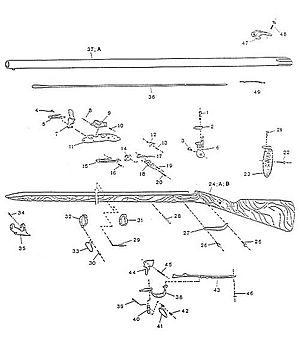
For his foot soldiers, Napoleon mainly gave them the Charleville M1777 Revolutionnaire musket. This gun was based on older designs. It was used during the French Revolution and the Napoleonic Wars. The Charleville musket was a smoothbore musket that was about 5 feet long. It fired a large bullet, about .69 caliber. It was a muzzle-loading gun, meaning you loaded it from the front of the barrel.
Well-trained French soldiers were expected to fire three shots per minute. A skilled soldier could hit a person-sized target at 100 yards. But hitting anything further away required a lot of luck. The musket was very inaccurate at long range. French officers usually carried a .69 pistol as a backup weapon to their sword. This pistol also had to be loaded from the muzzle and fired with a flintlock. Besides guns, soldiers used different kinds of pikes, swords, and bayonets for close-up fighting. Officers, sergeants, and cavalry mainly used swords. Most foot soldiers had bayonets attached to their muskets.
The cavalry (soldiers on horseback) and engineers usually carried a similar musket to the infantry. But their guns, called carbines and musketoons, were about 10 inches shorter. This made them easier to handle while riding a horse. However, they were less accurate. Besides firearms, heavy cavalry often used straight sabers with a 38-inch blade. The light cavalry used curved sabers with a 33-inch blade.
During the Napoleonic Wars, rifles also started appearing on the battlefield. Rifles were much more accurate, up to 200 paces. This was because the barrel had grooves that made the bullet spin. Even with this advantage, rifles were more expensive and took longer to load. Napoleon did not like this slowness. That is why he did not use many rifles in his army. He preferred the speed of the musket, which fit his fast movements.
The British, however, did use rifles. They had the Baker Pattern 1800 Infantry rifle. Some British units, like the elite 95th Regiment (Rifles), were fully equipped with them. One success of the British 95th Rifles was shooting French General Auguste François-Marie de Colbert-Chabanais in 1809 during the Peninsular War. The British themselves lost General Robert Ross, who was a veteran of the Peninsular War, to American long-range rifle fire in 1814. Rifles were also used in smaller numbers by Jäger companies in some German states.
The Austrian Army introduced the Girardoni M1780 repeating air rifle as a special weapon. They used them in the Napoleonic Wars. This gun could fire multiple shots and was loaded from the back. It was effective up to about 150 yards. It was almost silent and made no smoke or noise. But it was complicated and needed a lot of support to keep it working. The air rifle stopped being used after 1815. More common types of weapons proved better overall. In just a few more decades, all soldiers would have gunpowder rifles.
Most weapons for the French army came from armories that the French government fully controlled.
Artillery: Big Guns for Big Battles
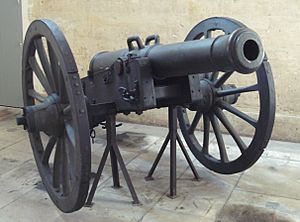
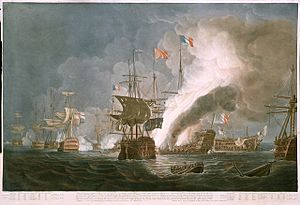
One of the most important parts of Napoleon's weapons was his artillery. Before Napoleon, during the Seven Years' War, combat weapons had improved a lot. Artillery became common in almost every European country, including France, with 12-pound and 8-pound cannons. The "Gribeauval guns" were developed between 1765 and 1774. These included 12-pounders, 8-pounders, 6-pounders, and 4-pounders, along with 6-inch and 8-inch howitzers.
These Gribeauval guns were Napoleon's favorite type of artillery. They were one-third lighter than cannons from other countries. For example, a British 12-pound cannon barrel weighed 3,150 pounds. The whole gun with its carriage weighed about 6,500 pounds. But a Gribeauval 12-pound barrel weighed only 2,174 pounds. The whole gun with its carriage weighed 4,367 pounds. Since Napoleon wanted speed and mobility, these lighter cannons gave him the flexibility he needed. Along with cannons, the army had many mortars, furnace bombs, and different types of cannon shots like grape and canister. All of these provided strong support fire.
Artillery also played a role in naval battles. Most ships had anywhere from 50 to 100 cannons. In 1798, Napoleon's main ship, L’Orient, had 120 guns. It was the most heavily armed ship in the world until it exploded that year at the Battle of the Nile. Napoleon's fast and powerful artillery helped him win most of his battles.
Special Weapons: Rockets!
The Congreve rockets were based on technology from Mysore (in India). The British army used these rockets often during the Napoleonic Wars.
See also
- Military history of France


